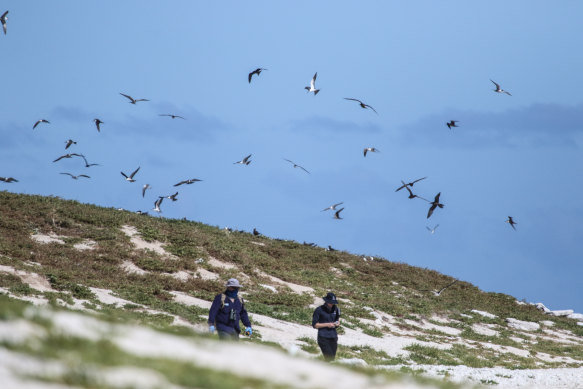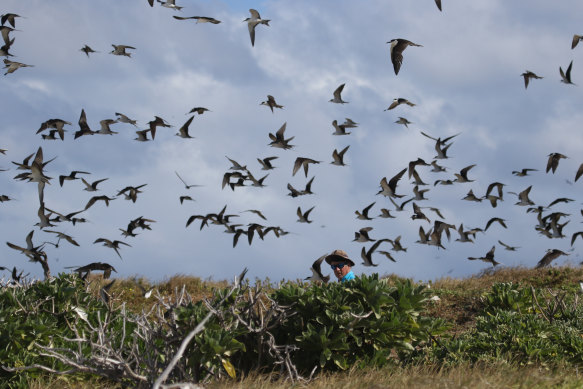This was published 5 months ago
‘A potential wildlife massacre’: Eyes on the sky as virus wings its way towards Australia
By Mike Foley
Binoculars at the ready, scanning the sky and peering into wetlands, an army of field workers is anxiously watching for birds carrying signs of a virus experts warn could be catastrophic for Australia’s wildlife.
The H5N1 strain of bird flu has killed millions of birds around the world in recent years, with outbreaks on every continent except Australia. Alarmingly, there is mounting evidence pointing to the virus evolving to enable mammal-to-mammal transmission.

Field workers looking out for a dangerous strain of bird flu in migratory birds.Credit: Guy Weerasinghe
Experts say it is a matter of when, not if, the virus arrives on our shores.
Australia is currently battling an outbreak of H7 bird flu, a relatively mild strain of the virus that has hit poultry farms in three states, forcing the mass culling of chickens and raising concerns about egg supply.
But the threat of H5N1 has mobilised thousands of volunteers, researchers and public servants, who have been deployed to look out for dead birds and take biological samples from migratory species as governments war game their response to an incursion.
University of Melbourne senior research fellow at the Centre for Pathogen Genomics Michelle Wille said: “It’s just a matter of when it’s going to arrive.
“This virus, H5N1, in the last 2½ years has spread to every continent on the planet except for Australia, with migratory birds crossing multiple oceans.
“It’s clearly capable of [travelling] long distances, spread by a large diversity of different birds, and it’s present in Asia above us, and we’ve got a lot of migratory birds going to that area.”
Wille and University of Queensland virologist Associate Professor Kirsty Short told this masthead an H5N1 outbreak would probably take a catastrophic toll on native birds because Australian species had not been exposed to the virus before.
A study released last year in the journal Genome Biology found the black swan was “extremely sensitive to highly pathogenic avian influenza”. While comparable studies have not been conducted on other Australian bird species, it is thought likely they could be similarly affected.

Experts say an H5N1 outbreak would probably take a catastrophic toll on Australian native birds.Credit: Guy Weerasinghe
The H5N1 virus emerged in the Northern Hemisphere before spreading south of the equator, but its impact has been particularly nasty in South America since late 2022.
Scientists have watched with growing alarm as 30,000 South American sea lions and 18,000 southern elephant seal pups have died from the virus. It has also been detected in 51 dairy herds across the United States.
Wille said scientific studies had not conclusively proved the virus was able to spread from mammal to mammal – rather than from contact with live birds or eating dead ones – but it was the most likely explanation.
“It is unlikely that it has jumped from birds to mammals that many times,” she said.
That is bad news for Australia’s marine mammals such as seals and endangered sea lions. And there is a risk it could be equally problematic for land mammals, with emus potentially more susceptible to spreading a form of the virus adapted to mammals.
“We’ve got a completely unique set of animals that haven’t really been studied in this context before,” the University of Queensland’s Short said. “It’s still somewhat theoretical, but it looks like emus are more likely to drive mammalian adaptations of the virus than other birds.”
Wille said Australia must be on the lookout for an incursion.
“This virus has been catastrophic everywhere that it has shown up and in cases where there has not been surveillance and preparedness, it has just ripped through wildlife populations, it’s ripped through poultry, it’s ripped through mammals and everyone is playing catchup,” she said.
Experts said wildlife could not be treated once infected with the H5N1 virus, but swift responses such as picking up the carcasses of infected animals, preventing farmed poultry from mixing with wild birds, and not feeding wild birds could limit impacts. There may also be potential to shield endangered species, for example by taking some of those most at risk into captivity to ensure species survival.
A meeting of state agriculture ministers, convened last week by federal Agriculture Minister Murray Watt, agreed to conduct a war-gaming exercise to test how biosecurity teams would react under different scenarios following an H5N1 incursion.
“The upcoming disaster preparedness exercise will allow a large cross-section of governments, stakeholders and the private sector to war our national preparedness,” Watt said.
The federal Agriculture Department has recently increased its efforts in the field, with teams out in wetlands, near dams and even at water treatment plants where migratory birds congregate, particularly in northern Australia. They are looking for species known to fly between H5N1 hotpots and Australia, and taking blood and other biological samples to test for the virus.
Invasive Species Council advocacy director Jack Gough said despite current efforts, governments should not be spared criticism of their preparations to date.
“We’ve known it’s coming, and it’s a potential wildlife massacre that for our birds could be on the scale of the Black Summer bushfires,” Gough said.
A volunteer army is backing up government efforts.
BirdLife Australia wetland birds program manager Chris Purnell said the grassroots organisation was informing its 8000 observers how to spot signs of bird flu in wild populations.
“Monitoring means having the boots on the ground,” Purnell said. “We’re getting a lot of waterfowl coming out of the Lake Eyre basin now that it’s drying. There’s been great recruitment in ducks and they’re now mobilising down into Victoria.”
There is no evidence that H5N1 is likely to start a human pandemic.
“Presently, the human risk remains low,” Wille said. But she added that international health agencies were “watching the situation very, very carefully”.
Vaccines are available for those who contract the virus, which has typically been workers in close contact with infected poultry or cows.
Federal Health Minister Mark Butler said the government, via the Australian Centre for Disease Control, was monitoring the situation, maintaining stockpiles of antiviral medication and working with international partners to ensure vaccines were available as needed.
Cut through the noise of federal politics with news, views and expert analysis. Subscribers can sign up to our weekly Inside Politics newsletter.